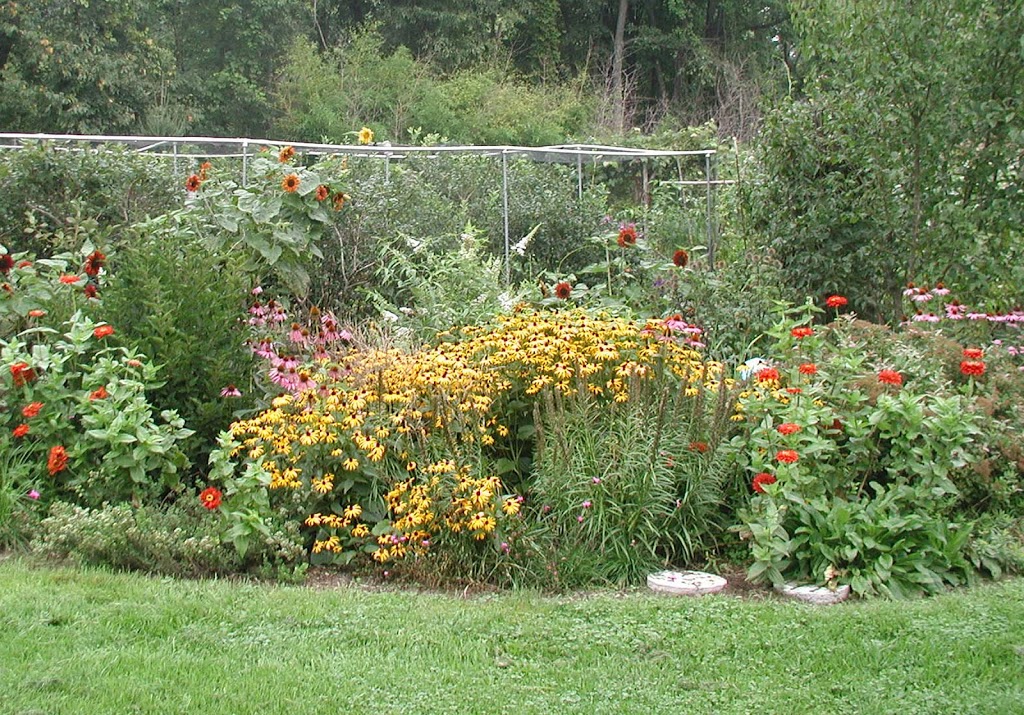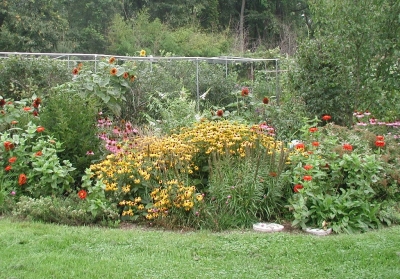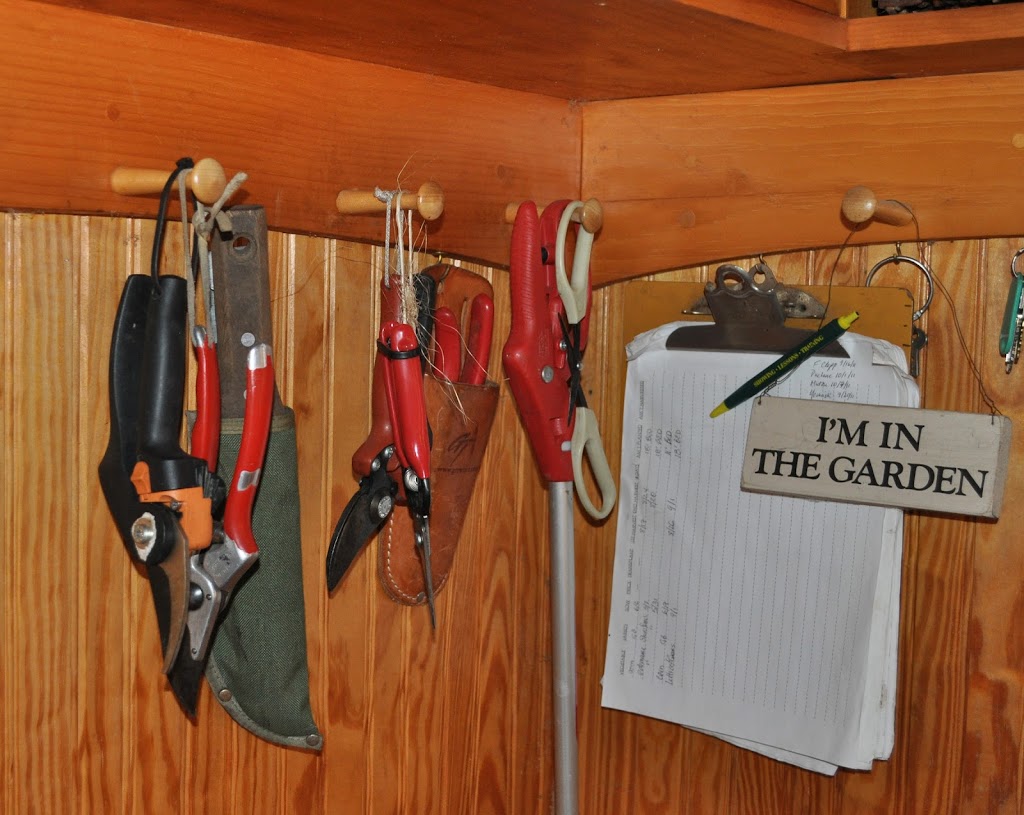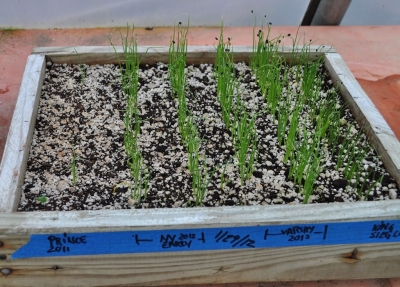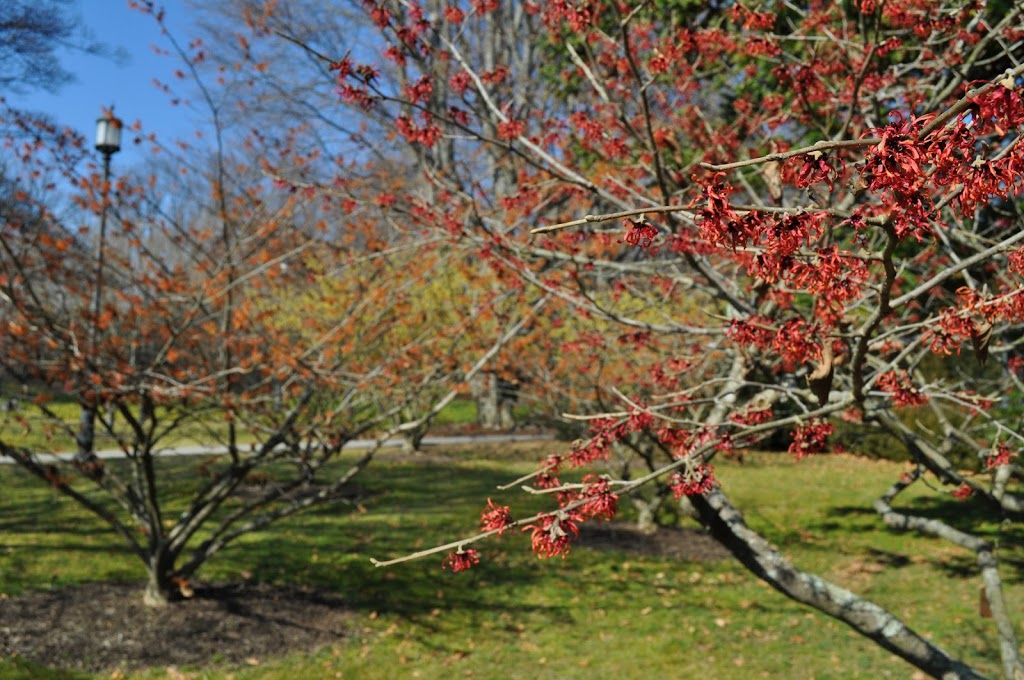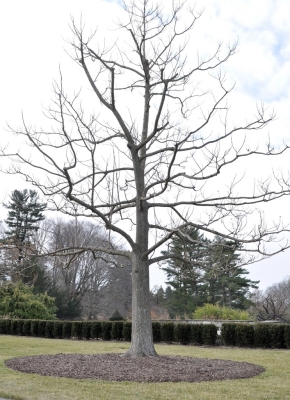Seedy Visions, Some Hard, Some Eeasy
/2 Comments/in Gardening/by Lee A. ReichWhat a perfect time of year to plant seeds. Yes, seeds! There’s no rush as to timing, with flower seeds, at least; there’s no worry about the soil being warm enough for germination; there’s no need to squeeze seed flats together near sunny windows; and there are plenty of empty seed flats.
Right now I have seedlings of endive, lettuce, kale, cauliflower, and cabbage growing in seed flats. The seedlings call the flats “home” for a month or more before they’re transplanted into beds now housing early corn, early bush beans, and other vegetables soon to be cleared away. Timing for these plants is critical if they’re going to be ready for harvest during the cool days from late September on into November. Cabbage and cauliflower were sown in early June, endive in early July, and lettuce, for a continued harvest through summer and fall, every two weeks or so all summer.
I’ve also sowed seeds with next year in mind. Flower seeds, in this case. Perennial flowers usually don’t flower their first year from seed. Ones that I sow this summer should make enough growth to put on a good show next year.
The flower bed undergoing renovation is crying out for black-eyed Susan plants (Rudbeckia hirta ‘Indian Summer), oodles of them. I could buy the plants but almost as easy and a lot cheaper and more satisfying is to buy a packet of seeds. One packet is going to provide many times the number of plants I need. Another bed needs more oriental poppies. Again, a packet of seeds is the more satisfying and economical way to go.
I have visions of blue spires of delphiniums rising up in the space between black currant plants and the fence to my south vegetable garden. A packet of ‘Pacific Giant’ delphinium seeds fills the bill, although these seeds are more difficult to germinate and the plants more difficult to grow than the poppies and black-eyed Susans. Delphinium seeds germinate best if fresh and some sources suggest chilling them awhile before or right after sowing. My plan is to plant them in a seed flat and set the covered flat on a bench that sits along the north side of my house — along with all the other seeds I am germinating. Another secret to germinating most seeds is patience.
——————————–
Patience surely has been the secret to my success with cyclamen seeds. Many years ago I purchased seeds of hardy cyclamens. Besides hardiness, these plants offer dainty blossoms that hover above the ground like small, pink butterflies. And when the plants aren’t in bloom, the speckled leaves earn the plants’ keep.
With the original batch of seeds came exacting instructions of temperature and time requirements for germination. I ended up with two seedlings from the whole packet of seeds, but those two seedlings have given rise to many more plants. A couple of weeks ago, the seed capsules, which are attached to a squiggly stalk, flared open to offer their ripe seeds, which I collected and sowed.
The flat of cyclamen seeds now sit on that same bench on the north side of my house. My only jobs now are to make sure the flat never dries out, which is unlikely, given the pane of glass that covers it, and to have patience.
———————————–
The most challenging seed of those I planned to sow this summer was chamomile, not because it’s at all hard to grow but because it’s hard to figure out just what is “chamomile.” Mostly, what people grow for tea is annual chamomile, but there’s also a perennial chamomile that’s been used medicinally. But just what is “annual” or “perennial” chamomile?
Usually, we garden nuts can fall back on botanical names to help out with such confusions. The fallback is not so easy with chamomile. Chamaemelum would seem an appropriate genus for chamomile and, in fact, C. nobile is a botanical name for perennial chamomile, which has also gone under the monikers of garden chamomile, Russian chamomile, and Roman chamomile. Not to confuse things, but this plant has also paraded under the botanical name Anthemis nobilis. Anthemis plants generally are referred to as dog fennels and, of course, chamomiles. Not to further confuse things, but I must mention A. tinctoria, golden marguerite, a wonderful ornamental in this genus, especially nice trained as a small tree with a head of white, daisy flowers.
Getting back to my tea, with annual chamomile . . . that’s Matricaria recutita, which, oddly, has the common name “sweet false chamomile.” It’s also gone under the botanical name of Tripleurospermum maritimum subsp. inordorum. And not to be confused with Matricaria matricarioides, pineapple weed, which grows all over the place and differs from any of the other chamomiles in that the flowers lack prominent, white petals. It has a pineapple-y aroma.
Bottom line: For my tea, I need annual chamomile, Matricaria recutita. Because it’s an annual, I’m going to wait until next year to sow it.
SEED LONGEVITY
/1 Comment/in Gardening/by Lee A. ReichWatching tiny, green leaves push up through the soil never ceases to amaze me, even after watching it happen for decades. And it’s all the more amazing with certain seeds, such as onions. It must be that I was scarred years ago by having a difficult time getting them to germinate. Well, I sowed them in the greenhouse a couple of weeks ago and they’re up and growing strongly. Most of them, at least.
My failure with onions years ago was due to old seed, and old for onion seed means anything more than a year old. Lettuce seed, in contrast, is one of the longest-lived of vegetable seeds and keeps up to 6 years. Here’s the life expectancy for other common vegetable seeds: 5 years for cucumber, endive, muskmelon, and radish; 4 years for beet, Brussels sprouts, cabbage, chard, eggplant, kale, mustard, pumpkin, tomato, turnip, and watermelon; 3 years for bean, broccoli, carrot, Chinese cabbage, pea, and spinach; 2 years for sweet corn, leek, okra, and pepper; and, along with onion, 1 year for parsley and parsnip. Under poor storage conditions — moist and warm, like my garage in summer — longevity is decreased.
Still, it seemed like such a shame to throw away good onion seed only a year old. So, in the seed flat a couple of weeks ago, a sowed one row of one-year-old onion seed alongside the rows of fresh onion seeds (and one row of leeks).
Confirmed: onion seed isn’t worth sowing after one year. In the seed flat are five neat rows of narrow, green sprouts and one barren row.
——————————————————–
Few seeds have as short a life as onion. More astounding is the longevity of some seeds, such as the 10,000 year old lupine seed that germinated after being taken out of a leming burrow in the Yukon permafrost. Just think: This same species was up and growing when humans first crossed the Bering Land Bridge, and saber-toothed cats and woolly mammoths may have brushed up against its leaves. Except that the story of the 10,000 year old lupine seed turned out to be apocryphal, as confirmed by radiocarbon dating.
The record for seed longevity is, in fact, 2,000 years and held by a date palm grown from seed recovered from an ancient fortress in Israel. But a recent discovery, once confirmed, will break that record by a long shot.
A kind of campion seed (Silene stenophylla) found buried, this time in a squirrel burrow, in Siberian tundra could very well be 32,000 years old. The seed has been grown into a charming, white-flowered plant.
Some coaxing was needed to get that original, 32,000 year old seed to sprout. A few cells, removed from the placenta, were grown under sterile conditions on a specially concocted growth medium. Once cells had multiplied sufficiently, the growing medium was altered to induce leaves, stems, and roots, and eventually the plants were robust enough to be planted in soil. The plant flowered and set seed, which germinated readily to produce more seedlings.
I wonder what seed has the shortest longevity. It’s not onion. Seeds in the family Tillandsioideae, related to pineapple, probably hold the record, with a viability of 4-6 weeks.
————————————————————–
Longwood Revisited
/1 Comment/in Gardening/by Lee A. ReichWitchhazel blossoms on February 5th! Not here, but down in Longwood Gardens in Kennett Square, PA, a public botanical and pleasure garden around which I had some time to wander before giving a lecture. One little grove was particularly fragrant and comely, with a few witchhazels shrubs with yellow blossoms, some with bright orange blossoms, and some with brownish orange blossoms.
February 5th is early for witchhazel even down there, reflecting what has been the mildest winter in memory. While many people prefer mild winters, this weather worries a lot of gardeners. Are plants going to become “soft?” Is possible cold weather in the weeks ahead going to do them in?
Call me a pollyanna, but I have a lot of faith in Mother Nature (or, put another way, natural systems) to adapt and protect against calamities. Not that everything will necessarily keep chugging along the way we humans like it, but that forests will remain forests, perhaps with some changes in species, and that garden plants should, in general, survive.
A few odd things are going on this winter here in the Northeast and over much of the rest of the country. First is the mild temperatures. People worry that plants might begin to grow too soon. But today’s and tomorrow’s temperatures aren’t the only things that shake plants awake this time of year. Daylength also comes into play, and no matter what the winter is like, daylength is the same on any given date from year to year.
Temperatures over the past weeks and months also come into play: Plants won’t begin growth until they’ve experienced a certain number of hours of cool — not cold — temperatures, signaling for them that winter is over and it’s safe to grow. Some winters, those hours begin to accumulate in autumn and then finish accumulating in late winter, when temperatures turn cool, not frigid, again. In the South and perhaps this far north, this winter at least, those hours could have accumulated sufficiently through winter to cause an early awakening of plants.
The first sign that many trees and shrubs show of awakening is the appearance of their flowers. These early blossoms could, in fact, succumb to subsequent cold weather. That cold could snuff out developing fruits, snuffing out this year’s crop. Or that cold weather could turn, say, an early tulip blossom from a handsome red cup to a wet dishrag on a stalk. In either case, the plants themselves, except for the blossoms and fruits should not be harmed.
The second odd thing about this winter is the lack of snow cover. Snow reflects light and heat from winter sun. Evergreens don’t like this at a time when their roots are cold and not especially active. The result is scorched leaves. Bark also can scorch, except this time it’s called scalding, when winter sun heats up dark bark by day and then bark temperatures plummet as the sun drops below the horizon.
On the plus side, snow is a great insulator. It helps modulate soil temperatures to minimize alternate freezing and thawing, which can heave plants up and out of the soil. Heaving is especially a problem with young or new plants, as yet hardly rooted. That insulating, white blanket also lessens roots’ exposure to cold. Without snow, less cold-hardy plants (and we gardeners are always pushing the limits) might show more winter damage.
Then again, snow isn’t the only insulator. Any good gardener mulches plants to provide nutrients, to conserve water, to build up humus, and to feed beneficial soil life. I’m banking on those layers of wood chips, leaves, straw, and other organic materials I spread through autumn to protect my roots — plants’ roots, that is.
————————————————————–
No question about it: Temperatures, on average, have warmed in recent years. Plants are responding. But how? Trees, for example.
To help answer such questions, the Smithsonian Institute recently began a citizen science program to track tree growth throughout the world. The way it works is that, after signing up to become a “citizen scientist,” you’re sent a tree banding kit along with instructions for attaching the tree band, selecting study trees, and gathering and reporting data. Information, including a video, is available at https://treebanding.si.edu.
It’s all free, it’s all interesting, and your data, along with that of citizen scientists worldwide, will help us better understand tree growth, and what’s affecting it, over the years.
————————————————————–
Turning my thoughts back to Kennett Square and Longwood Gardens . . . I’m jealous. Not of their awesome, main conservatory fragrant with citrus trees and lilies in bloom. (I have a small greenhouse, and a kumquat, a citrus relative, that blooms in summer.) Not of their small greenhouse that is home to espaliered peach and nectarine trees and to a dozen or so potted fig trees. (Three fig trees grow in my greenhouse.) Not of their grove of witchhazels in various shades of yellows and reds. (I have one yellow witchhazel.)
What I am jealous of is the care that each of their plants receive; each one is perfect. If an old leaf or spent flower drops on the ground, someone picks it up. Each stem of their peach and nectarine espaliers is tied neatly to its trellis, as are the high vines clambering up pillars in the greenhouse. Outdoors, each tree is pruned to perfection, with none of their branches crowding, with any diseased or dead limbs lopped off cleanly. Looking closely enough, I did, at least, see some evidence of scale insects on their large potted grapefruit plants in the conservatory. (My large potted bay laurel also shows evidence of scale.)
My gardens, indoors and out, would be much improved with their knowledgeable crew of helpers.

